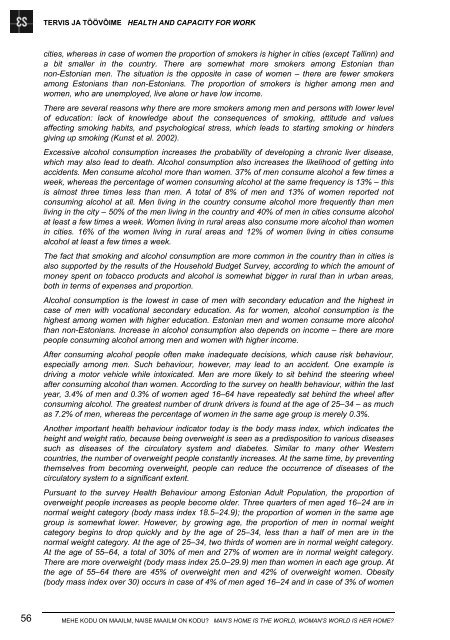MEHE KODU ON MAAILM, NAISE MAAILM ON KODU? - Tartu Ãlikool
MEHE KODU ON MAAILM, NAISE MAAILM ON KODU? - Tartu Ãlikool
MEHE KODU ON MAAILM, NAISE MAAILM ON KODU? - Tartu Ãlikool
Create successful ePaper yourself
Turn your PDF publications into a flip-book with our unique Google optimized e-Paper software.
TERVIS JA TÖÖVÕIME HEALTH AND CAPACITY FOR WORK<br />
cities, whereas in case of women the proportion of smokers is higher in cities (except Tallinn) and<br />
a bit smaller in the country. There are somewhat more smokers among Estonian than<br />
non-Estonian men. The situation is the opposite in case of women – there are fewer smokers<br />
among Estonians than non-Estonians. The proportion of smokers is higher among men and<br />
women, who are unemployed, live alone or have low income.<br />
There are several reasons why there are more smokers among men and persons with lower level<br />
of education: lack of knowledge about the consequences of smoking, attitude and values<br />
affecting smoking habits, and psychological stress, which leads to starting smoking or hinders<br />
giving up smoking (Kunst et al. 2002).<br />
Excessive alcohol consumption increases the probability of developing a chronic liver disease,<br />
which may also lead to death. Alcohol consumption also increases the likelihood of getting into<br />
accidents. Men consume alcohol more than women. 37% of men consume alcohol a few times a<br />
week, whereas the percentage of women consuming alcohol at the same frequency is 13% – this<br />
is almost three times less than men. A total of 8% of men and 13% of women reported not<br />
consuming alcohol at all. Men living in the country consume alcohol more frequently than men<br />
living in the city – 50% of the men living in the country and 40% of men in cities consume alcohol<br />
at least a few times a week. Women living in rural areas also consume more alcohol than women<br />
in cities. 16% of the women living in rural areas and 12% of women living in cities consume<br />
alcohol at least a few times a week.<br />
The fact that smoking and alcohol consumption are more common in the country than in cities is<br />
also supported by the results of the Household Budget Survey, according to which the amount of<br />
money spent on tobacco products and alcohol is somewhat bigger in rural than in urban areas,<br />
both in terms of expenses and proportion.<br />
Alcohol consumption is the lowest in case of men with secondary education and the highest in<br />
case of men with vocational secondary education. As for women, alcohol consumption is the<br />
highest among women with higher education. Estonian men and women consume more alcohol<br />
than non-Estonians. Increase in alcohol consumption also depends on income – there are more<br />
people consuming alcohol among men and women with higher income.<br />
After consuming alcohol people often make inadequate decisions, which cause risk behaviour,<br />
especially among men. Such behaviour, however, may lead to an accident. One example is<br />
driving a motor vehicle while intoxicated. Men are more likely to sit behind the steering wheel<br />
after consuming alcohol than women. According to the survey on health behaviour, within the last<br />
year, 3.4% of men and 0.3% of women aged 16–64 have repeatedly sat behind the wheel after<br />
consuming alcohol. The greatest number of drunk drivers is found at the age of 25–34 – as much<br />
as 7.2% of men, whereas the percentage of women in the same age group is merely 0.3%.<br />
Another important health behaviour indicator today is the body mass index, which indicates the<br />
height and weight ratio, because being overweight is seen as a predisposition to various diseases<br />
such as diseases of the circulatory system and diabetes. Similar to many other Western<br />
countries, the number of overweight people constantly increases. At the same time, by preventing<br />
themselves from becoming overweight, people can reduce the occurrence of diseases of the<br />
circulatory system to a significant extent.<br />
Pursuant to the survey Health Behaviour among Estonian Adult Population, the proportion of<br />
overweight people increases as people become older. Three quarters of men aged 16–24 are in<br />
normal weight category (body mass index 18.5–24.9); the proportion of women in the same age<br />
group is somewhat lower. However, by growing age, the proportion of men in normal weight<br />
category begins to drop quickly and by the age of 25–34, less than a half of men are in the<br />
normal weight category. At the age of 25–34, two thirds of women are in normal weight category.<br />
At the age of 55–64, a total of 30% of men and 27% of women are in normal weight category.<br />
There are more overweight (body mass index 25.0–29.9) men than women in each age group. At<br />
the age of 55–64 there are 45% of overweight men and 42% of overweight women. Obesity<br />
(body mass index over 30) occurs in case of 4% of men aged 16–24 and in case of 3% of women<br />
56<br />
<strong>MEHE</strong> <strong>KODU</strong> <strong>ON</strong> <strong>MAAILM</strong>, <strong>NAISE</strong> <strong>MAAILM</strong> <strong>ON</strong> <strong>KODU</strong>? MAN’S HOME IS THE WORLD, WOMAN’S WORLD IS HER HOME?

















